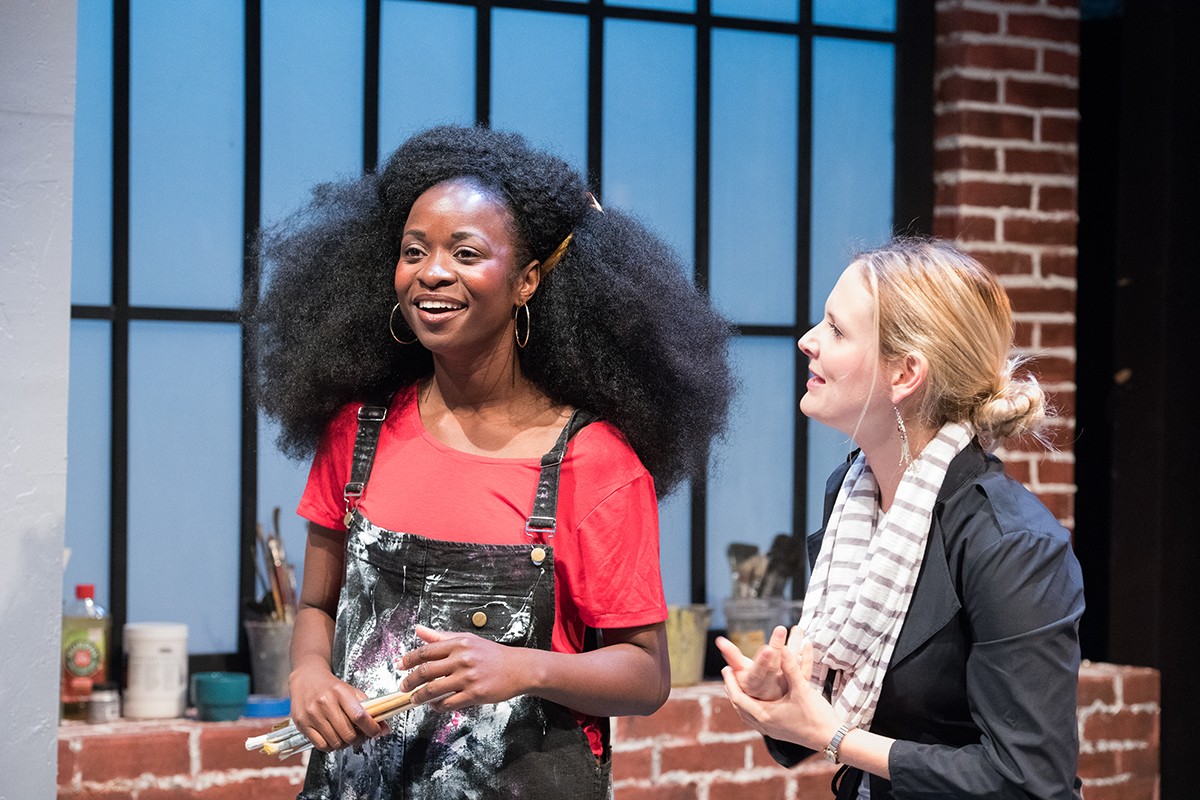
It’s amazing how often playwright James Ijames’ blistering White causes outright laughter.
After all, staring into the face of racism bleached bare by themes of white privilege, cultural and gender bias, economic stratification, or gay elitism is a self-confrontational task. Equally astounding is a haunting mirror effect that lasts for days — and hopefully, forever. After being jolted into awareness and looking back or ahead to where your footprints fall along lines that define and divide humanity, the responsibility for racism is clearly self-determined. Deciding if you come up innocent or guilty as charged is rarely more funny, horrid, or simultaneous.
Theater that reverberates with these lasting, discordant tones is admirable. At Shotgun Players, White‘s tightly constructed, topical, 95-minute script wields trendy clichés like everyday kitchen knives in the hands of a sword juggler, but through the playwright’s clever placement, context, and vocal inflection, they make deep cuts. Directed with consistent acumen by M. Graham Smith, strong performances by the four-member cast magnify both pleasure and pain. Intuitive set design from Nina Ball, shrewd costumes by Ulises Alcala, and intimate choreography well-staged by Kevin Clarke combine for a minimalist approach to maximum effect in the no-intermission production. Only in a final scene, in which a character bounces between two personas, does the play falter, and that misstep is largely due to easily fixable, too-fast pacing.
Gus (Adam Donovan) is a gay, white male contemporary fine artist. His friend from graduate school years, Jane (Luisa Frasconi), is the new curator at a prestigious museum. Charged with presenting her first show, the New America exhibition, she breaks the bad news that his almost-all-white paintings “need more blue” and won’t be included. Regardless of palette, his work is “too much chicken sausage” (aka “white meat”) to fit her agenda.
Gus rails and wails at the injustice of Jane’s unwritten “no white dudes” rule. In his nightmarish, myopic despair, his inner Black woman emerges: a sequined “Saint Diana”/Diana Ross character (Santoya Fields). Eventually, Gus dubs her his “Blafrican American.”
Upon recalling a female Black actor named Vanessa, who he saw while attending a play with his Asian boyfriend, Tanner (Jed Parsario). Gus invites Vanessa to his studio. He has an idea: to audition her for a role cooked up out of his frustration about the exhibit. Vanessa will play the part of a female artist of color as his stand-in and get his work into Jane’s show. After some resistance, Vanessa agrees to participate. Together, they devise Balkonaé (pronounced like “balcony” but ending with an accented, long “a”), a 31-year-old, vegan, lesbian, color-blind Yale graduate who plays cello and piano. She read Zora Neale Hurston’s Their Eyes Were Watching God at age 15 and speaks multiple languages, including Farsi. Balkonaé’s artwork, they determine, will be labeled, “Bad Bitch Expressionist.”
Fields, triple cast with brilliant results as diva Diana/actor Vanessa/artist Balkonaé, gives a commanding performance that continually raises the bar, upping the bite of felt racism to cry-worthy levels.
Jane falls for Gus’ and Vanessa’s invention — under the ruse, Gus’ art will be featured in the exhibit. Vanessa has found her ambiguous but nonetheless starring role. Collaboration and misappropriation engage in all-out war when Vanessa/Balkonaé takes control of her own reins. A number of plot switchbacks — who knows the truth behind which deceptions when — combine for a supercharged ending.
Importantly, part of the play’s considerable power comes from its source in a true story. White is loosely based on similar actions taken by white artist Joe Scanlan for the 2014 Whitney Biennial exhibition of contemporary art in New York. Scanlon engaged African American actor Jennifer Kidwell to play “Donelle Woolford,” a fictional persona he invented to present his art. The resulting controversy caused some artists of color to withdraw from the exhibition. Conversations erupted as people either protested the exploitation of Black women or purported that the scandalous actions prompted necessary public dialogue about ongoing racism in the art world.
There are no pure heroes in White. Even Tanner, the least compromised character, buries his values while supporting his lover’s deceptions. And there is risk in remembering only the play’s humor or deciding that Vanessa’s complicity means she is merely another pawn in a white man’s game — and arguably compounding the offense, she’s a Black woman exploited by a Black male, the production’s playwright. Any of these responses might mean audience dialogue about racism comes to a halt, which would be a sure loss.
In a final scene, Vanessa/Balkonaé warns that in light of persistent, dehumanizing racism, “a raging sea” might be unleashed. Snapping her fingers, the lights go out. Through laughter and tears, with art that holds pain and pleasure in one frame, White points the finger at each of us.
Through Aug. 5, $25–$37, 1901 Ashby Ave., Berkeley, ShotgunPlayers.org.












